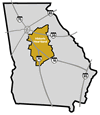
Wildlife Viewing Guide


|
Wildlife Viewing Guide |
 |
 Ocmulgee
National Monument
Ocmulgee
National Monument
Description: An archaeological and natural history treasure preserved to showcase and interpret 10,000 years of human habitation in the area, Ocmulgee National Monument is uniquely located on the Fall Line sand hills separating the once ocean-covered Coastal Plain from the hilly Piedmont region. This site includes mowed fields, mixed pine-hardwood forest, broad river floodplain and beaver swamps. Here is the beginning of the magnificent Ocmulgee River flood plain which is up to 5 miles wide and extends downriver to its confluence with the Oconee River, forming the great Altamaha. 6 miles of trails provide easy access to the wide variety of habitats of the area.
Viewing Information: This site is well-known for its great birding. The northernmost extent of Coastal Plain river flood plain habitat is found here. Birds generally found much farther south may be seen in the area during summer. These include the prothonotary warbler, parula warbler, Swainson's warbler, yellow-crowned night herons, and great egret. Bald eagles, swallow-tailed kites, or Mississippi kites might be seen soaring high over this broad floodplain, searching these remote wetlands for food. White-tailed deer, foxes, bobcats, coyotes, and rabbits are numerous along the trails crisscrossing the upland portion of this National Monument. Several short trails highlight bottomland habitats where beavers, river otters, raccoons, and muskrats can be seen, along with many species of ducks and wading birds.
Directions: From Macon, take I-16 to exit 4 (Coliseum Drive). Go east on US Hwy. 80 apx. 1 mile to the park entrance on the right.
Management: National Park Service, 912-752-8257
Closest Town: Macon, GA
Additional Information: The visitors center houses a significant regional archaeological museum.
![]()
![]()
![]()
![]()
Read and add comments about this page